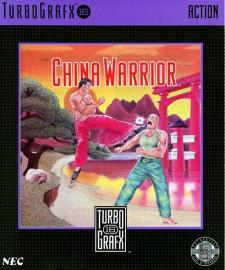China Warrior
This article needs additional citations for verification. (May 2007) |
| China Warrior | |
|---|---|
 Front cover of China Warrior package. | |
| Developer(s) | Hudson Soft |
| Publisher(s) | Hudson Soft, NEC |
| Platform(s) | TurboGrafx 16/PC Engine, Virtual Console, PlayStation Network, Mobile phone |
| Release | JP November 21, 1987 US 1989 |
| Genre(s) | Beat'em up |
| Mode(s) | Single player |
China Warrior, known in Japan as The Kung Fu (THE 功夫 (ザ・クンフー)), is a horizontal beat'em up video game created in 1987 by Hudson Soft for the TurboGrafx-16. The game was ported to mobile phones and the Hudson Channel for the PS2 exclusively in Japan with redone graphics, audio, and gameplay. The PC Engine version was also released for the Wii's, Nintendo 3DS's, and Wii U's Virtual Console and on the Japanese PlayStation Store.
Description
Story
A Chinese martial artist named Wang (王(ワン)), whose style resembles that of Bruce Lee, embarks on a mission to bring down opposing enemies and the Dark Emperor, who stands atop the castle Lu Hao Yang (洛陽閣(ルーヤンカク)) in China.
Gameplay
The object of the game is to walk through each stage while throwing punches and kicks at enemies and objects, which also can be done in midair. There are four stages which are broken down into three stages each, for a total of twelve stages. When Wang gets knocked out, the game starts over at the beginning of the stage in which he got knocked out. Players can memorize the object/enemy pattern in order to get through the stage more easily whenever Wang gets knocked out. At the end of each level, there is a boss fight. The control was designed to be similar to the arcade game Kung-Fu Master, but with gameplay similar to Gladiator without the sword or shield held in hand. The graphics utilized very large character models that fill up the screen. They were capable of moving without any graphical flickering.
Reception
In 1987, the character size and detail was a positive selling point for the title in Japan.[1] The release would not reach US until 2 years later. By then, the title faced much tougher competition against games like Last Battle and Altered Beast. IGN denounced the game for its overly limiting gameplay, forcing the player to constantly move right.[1] In addition, while the graphical advancements of the game were prominent, many felt that they were not substantial enough to pardon the game's critical flaws. In the game's review for Wii's Virtual Console, IGN and Gamespot gave the game an abysmal review, citing bad graphics and repetitive gameplay, among other things.[1][2] The game was also featured in 1UP's "Broken Pixels," a show dedicated to mocking bad video games.[3]
